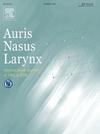舌咽闭合的语咽分离对肌萎缩性侧索硬化症和重症肌无力的鉴别
IF 1.5
4区 医学
Q2 OTORHINOLARYNGOLOGY
引用次数: 0
摘要
目的喉镜检查腭咽闭合时出现语咽分离(SSD)是假性球麻痹的表现之一。我们假设这一发现可以区分肌萎缩侧索硬化(ALS)和重症肌无力(MG)。本研究旨在鉴别鉴别这两种疾病的喉镜检查结果。方法回顾性分析在我院行纤维喉镜检查的有球部症状的肌萎缩性侧索硬化症和MG患者。评估以下喉镜项目:发声和吞咽的腭咽功能不全(VPI)、咽收缩、声带运动和唾液状态。结果共纳入107例患者,其中肌萎缩侧索硬化症70例,肌萎缩侧索硬化症37例。发音中VPI的患病率在ALS组中明显更高(40% vs. 19%;P = 0.027)。肌萎缩性侧索硬化症(ALS)组舌咽部闭合时SSD的患病率也显著较高(33% vs. 3%;P & lt;0.001)。其他喉镜检查结果在两组之间没有差异。多因素logistic回归显示,腭咽闭合时SSD与ALS独立相关(优势比26.64;95%置信区间为2.24-317.58;P = 0.009)。结论舌咽部闭合时的ssd可用于鉴别肌萎缩侧索硬化症与MG。本文章由计算机程序翻译,如有差异,请以英文原文为准。
Speech-swallow dissociation in velopharyngeal closure for differentiating amyotrophic lateral sclerosis and myasthenia gravis
Objective
Speech-swallow dissociation (SSD) in velopharyngeal closure on laryngoscopy is a sign of pseudobulbar palsy. We hypothesized that this finding could differentiate amyotrophic lateral sclerosis (ALS) from myasthenia gravis (MG). This study aimed to identify laryngoscopic findings useful in differentiating these two diseases.
Methods
ALS and MG patients with bulbar symptoms who underwent fiberoptic laryngoscopy in our hospital were retrospectively examined. The following laryngoscopic items were evaluated: velopharyngeal incompetence (VPI) in phonation and swallowing, pharyngeal constriction, vocal cord movement, and salivary status.
Results
One hundred seven patients (70 with ALS and 37 with MG) were included for analysis. The prevalence of VPI in phonation was significantly higher in the ALS group (40 % vs. 19 %; P = 0.027). The prevalence of SSD in velopharyngeal closure was also significantly higher in the ALS group (33 % vs. 3 %; P < 0.001). The other laryngoscopic findings did not differ between the groups. Multivariate logistic regression showed that SSD in velopharyngeal closure was independently associated with ALS (odds ratio, 26.64; 95 % confidence interval, 2.24–317.58; P = 0.009).
Conclusion
SSD in velopharyngeal closure is useful for differentiating ALS from MG.
求助全文
通过发布文献求助,成功后即可免费获取论文全文。
去求助
来源期刊

Auris Nasus Larynx
医学-耳鼻喉科学
CiteScore
3.40
自引率
5.90%
发文量
169
审稿时长
30 days
期刊介绍:
The international journal Auris Nasus Larynx provides the opportunity for rapid, carefully reviewed publications concerning the fundamental and clinical aspects of otorhinolaryngology and related fields. This includes otology, neurotology, bronchoesophagology, laryngology, rhinology, allergology, head and neck medicine and oncologic surgery, maxillofacial and plastic surgery, audiology, speech science.
Original papers, short communications and original case reports can be submitted. Reviews on recent developments are invited regularly and Letters to the Editor commenting on papers or any aspect of Auris Nasus Larynx are welcomed.
Founded in 1973 and previously published by the Society for Promotion of International Otorhinolaryngology, the journal is now the official English-language journal of the Oto-Rhino-Laryngological Society of Japan, Inc. The aim of its new international Editorial Board is to make Auris Nasus Larynx an international forum for high quality research and clinical sciences.
 求助内容:
求助内容: 应助结果提醒方式:
应助结果提醒方式:


